Introduction To Khai Dinh Tomb
Titled the pinnacle of royal architecture, the Khai Dinh Tomb in Hue (also well-known as Ứng Lăng Mausoleum) is one of the most captivating tourist attractions in Vietnam. As the resting place for the penultimate (twelfth) Emperor of the Nguyen Dynasty, Khai Dinh, the royal tomb of Khai Dinh boasts a unique blend of Western and Eastern architecture.
Besides, not far away from the city center and nestled on an idyllic hillside, the Mausoleum of Emperor Khai Dinh deserves to be on travelers’ bucket lists. Why not get to know this famous heritage site with Culture Pham Travel? You must want to grab your backpack and visit it right away!
How To Get To Khai Dinh Tomb Hue Vietnam?
The Tomb of Khai Dinh is roughly 9 kilometers to the south of the city center, which will take about 14 minutes to go by car. It’s on a steep hill on Chau Chu Mountain, which is on the peaceful outskirts of Hue City. Thus, the Khai Dinh Tomb location makes it an ideal setting for an emperor’s resting place.
Please refer to the Khai Dinh Tomb map below to get more details:
There are many methods to get to the mausoleum, including booking a Grab bike or taxi, catching a cyclo, hiring private cars, going on a tour, cycling, or even walking. We highly recommend a fantastic way to greatly enjoy yourself – Hue tours, such as:
- Hue Royal Tombs Tour – from 65 USD/pax
- Hue City Tour From Da Nang – from 56 USD/pax
- Hue City Tour 1 Day – from 48 USD/pax
- Hue Deluxe Group Tour – from 43 USD/pax
- Hue City Tour By Private Car – from 43 USD/pax
Our high-quality tours will maximize your precious time in Hue by combining your time in Khai Dinh Tomb Vietnam with other highlight attractions such as the dragon boat trip on the Perfume River, Thien Mu Pagoda, Minh Mang Tomb, Hue Imperial Citadel, and the Royal Tomb of Tu Duc.
Khai Dinh Tomb Entrance Fee
The Khai Dinh Tomb Hue Vietnam is open from 7 a.m. to 5 p.m., every day. To visit the Tomb of Khai Dinh Hue Vietnam and contribute to the great preservation of the UNESCO Heritage, you have to buy an entrance ticket. It costs VND 150,000 per person for adults and VND 30,000 for kids. Children under 5 years old are free of charge.
Best Time To Visit Tomb Of Khai Dinh Hue
The best time to visit Khai Dinh Tomb and other attractions in Hue is during the dry season, which lasts from January to September. Yet Hue sees the most favorable weather during January and February, when there is no intense heat or high precipitation. Thus, you should visit the mausoleum and other Hue attractions during the spring.
So, how long should you spend on Khai Dinh Tomb? It will take you 1-2 hours to discover every corner of this site. If you intend to make a visiting combo with other places, it may take 3 hours to a whole day.
Khai Dinh Tomb History
Before going into architectural details, you should know some information about Emperor Khai Dinh and his mausoleum. Khai Dinh Emperor (1885–1925), who was regarded as a “puppet” of the French, came to the throne in 1916 at the age of 31, and his reign lasted for 9 years.
Like his predecessors, the emperor built numerous buildings, palaces, and, of course, his own tomb, which is a “home in the afterlife” for himself. Rooted in Oriental beliefs, all emperors thought that present life was just a temporary life; you would only live an eternal life once you passed away. Therefore, they believed that what you needed in this life, you would need in the afterlife.
Khai Dinh aimed at a so complicated mausoleum that the construction lasted 11 years, and finally, in 1931, his successor Bao Dai completed it. To finish this masterpiece, builders went to France to buy cement and to China and Japan to get colored glass, porcelain, and ceramics. Then, they broke them into small pieces to inlaid to decorate. Surprisingly, 20 thousand workers contributed to the Khai Dinh Tomb in 11 years.
Sadly, to carry out his tomb’s construction, the emperor asked the French to raise farming taxes up to 30 percent to get enough money. As the country was so poor back then, people were extremely unhappy about this. However, under the double levels of control from the French and the Nguyen monarchy, the people had no choice.
What Makes The Tomb Of Emperor Khai Dinh Special?
A Blend Of Many Different Architectures
As opposed to the other royal tombs, the royal Mausoleum of Emperor Khai Dinh is the smallest, approximately a half hectare. However, with its intricate architecture, it is the most luxurious tomb in Vietnam. It is known for its unique architectural combination of Vietnamese and Western styles, creating an exotic space for visitors.
One interesting fact is that Khai Dinh has a soft spot for foreign elements, especially the beauty of modern Western culture. Hence, his mausoleum is a harmonious blend of European and Vietnamese architecture. The tomb also includes other architectural features of Hinduism, Buddhism, Roman, and Gothic.
Perfect Fengshui Location
The position of the Royal Tomb of Khai Dinh King was worked out carefully. When he first came to the throne, he ordered the best Fengshui tellers to go all over the place to choose the best Fengshui places for his tomb. Eventually, they found a site situated perfectly on a moderate hillside in the southwest of Hue Imperial Citadel.
That gentle leaning area was evaluated as a “bed for a dignitary soul,” like Emperor Khai Dinh. Indeed, the site lies on Chau Chu Mountain, not too high but in the open air with nature around it. If you stand in this place, you will feel nature’s call—winding streams at the mountain foot, layers of distant hills, and a green forest space.
Khai Dinh Tomb Video
What To See At The Tomb Of Khai Dinh Emperor?
Dragons Alongside Stairs To The Courtyard
You must climb a large number of steps to access the iron gate of the Tomb of Khai Dinh Vietnam. The colossal staircase strikes many travelers right when they reach the site, creating an impressive highlight of the mausoleum. Next, once passing the gate, you will enter a courtyard featuring traditional mandarins’ working buildings made out of reinforced concrete, both on the left and right.
To reach the forecourt level in front of the tomb, travelers must climb another nearly 40 steps. One remarkable thing is the two dragons lying beside the steps, forming a beautiful set of banisters. Two sets of stairs contribute to the layer system of this relic, promoting a sense of depth.

Honor Guard Formation on the Honour Courtyard
In the big yard, there are 2 couple rows of elephants, horses, mandarins, and soldiers. All sculptures are carved by bluestone. Compared to other royal tombs in Hue, the royal Tomb of Khai Dinh King has 2 more rows of soldiers standing in two lines on either side of the forecourt.
As you can see, they are waiting for the Emperor to do business in the afterlife. It looks like a “King’s chess table” looked from above.
The Stele Pavilion
In the heart of the forecourt, there is an octagonal pavilion with a 10-ton heavy and 3.1-meter high stele that commemorates Khai Dinh Emperor’s biography and his achievements. In honor of his father, Emperor Bao Dai erected this stele, named it “Bi Dinh”, and wrote its contents by himself.
On its left and right sides are two pillars, symbolizing two candles that illuminate the emperor’s soul in the afterlife.
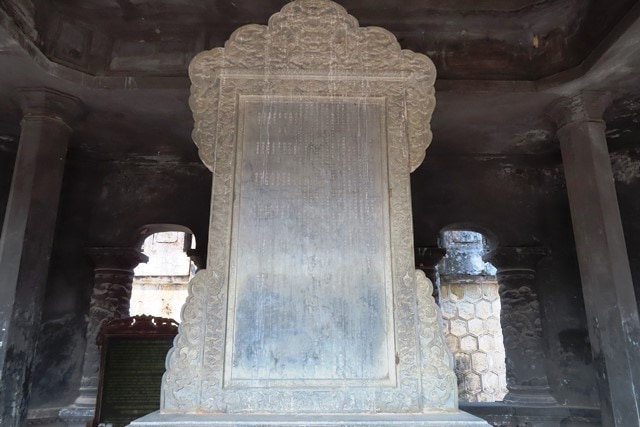
Khai Thanh Palace
Step up some more, we get into Khai Thanh Palace. You will say WOW because of its impressive beauty and decoration. Four corners of the tomb are adorned with paintings of the four seasons, filled with mosaics from colored glass and porcelain from China and Japan.
The most special about Tombeau de Khai Dinh is the ceiling painting—”Nine Dragons Hidden in the Clouds”. It depicts majestic Vietnamese dragons, appearing among billowing clouds. Stylized images of dragons and clouds are dipped in elegant hues and smooth strokes, creating eye-catching sights. It is the only ceiling painting that still exists in Vietnam so far.

An interesting story about this painting is that artist Phan Van Tanh, the author of the painting, painted it with his feet. A long time ago, with the high platform, if you drew by hand it was close to your eyes so you could not see the panorama. So he found that foot-drawing is a more effective way.
When the Khai Dinh Emperor came to the tomb to manage the construction, he saw the artist drawing a dragon face by his feet, which was taboo to the royals back then. Even though the emperor was so angry, he had no other option. No one could replace Tanh as he was so talented.
Since the painting turned out to be excellent, when Tanh completed his job, he got a promotion instead of getting killed for the offensive painting method.
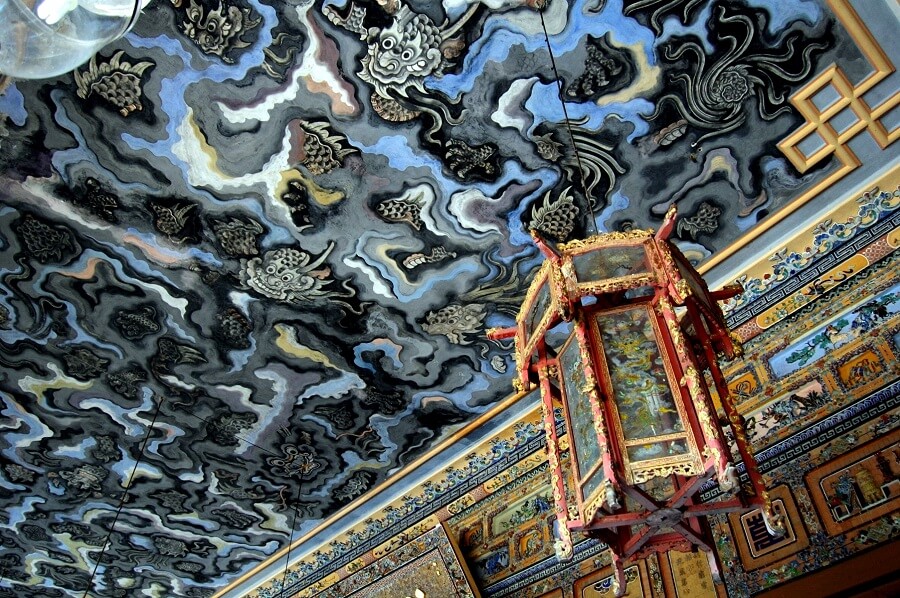
Thien Dinh Palace
Khai Dinh’s tomb architecture is extremely unique and possesses a mischievous royal vibe. Behind the altar with a portrait of Khai Dinh Emperor is his full-body bronze statue. It was a French casting work in 1920 following the right size of the Khai Dinh.
As you might know, the statue is the 39th birthday gift the French government offered to the emperor. In other Hue Royal Tombs, you don’t know exactly where the Emperor’s coffin is. In Khai Dinh Tomb Hue, however, you can find it right away. Under the bronze sculpture, 9 meters deep is the coffin and body of the Khai Dinh Emperor.
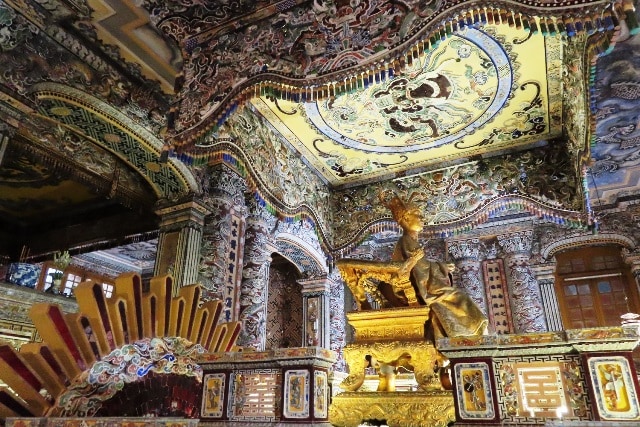
Right behind his back is the symbol of Sunset. It means the Emperor has passed away already. Above his head is a parasol with 99 dragons watching you in any direction to protect the emperor. With tough materials like concrete, colored glass, and porcelains, it looks both solid and delicate like real silks moving in the winds.
On the right and left-hand sides of Khai Thanh Palace are the rooms for the guardians who were protecting the tomb. Nowadays, they are a small museum with a lot of photos and mementos of the Khai Dinh Emperor.
Things You Should Notice
- As the staircases are quite steep, you should pay attention while climbing to avoid undesirable accidents.
- You should learn about the tomb beforehand for a more meaningful visit. Otherwise, you can book a tour with a local tour guide who will give you interesting details.
- You must wear comfortable shoes to climb up 127 steps to reach the Khai Dinh Emperor Tomb.
- In the dry season, remember to wear sunglasses, hats, and sunscreen, as well as bring bottles of water.
- In the rainy season, you should wear raincoats or bring umbrellas.
Conclusion
In conclusion, we have just found out about Khai Dinh Tomb Hue, the smallest but most costly among Nguyen Royal Tombs. There is no doubt that the Tomb of Khai Dinh is a must-see spot in the ancient citadel of Vietnam. Its intricacy and distinction in architecture take visitors to a scope of art, culture, and history.
If you are going to visit Hue City, don’t forget to come by this tourist attraction to witness its striking scale. We ensure that its overwhelming beauty is worth your time.

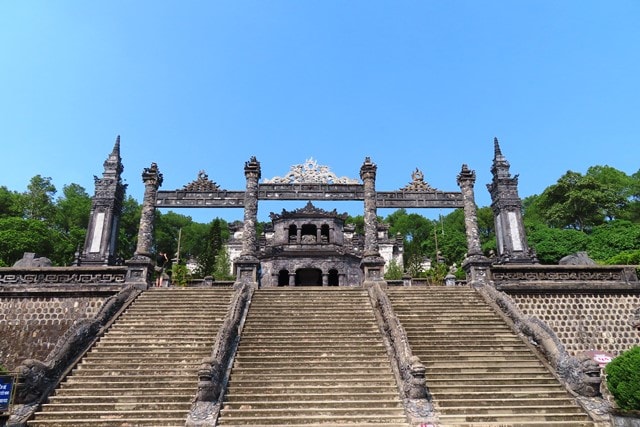
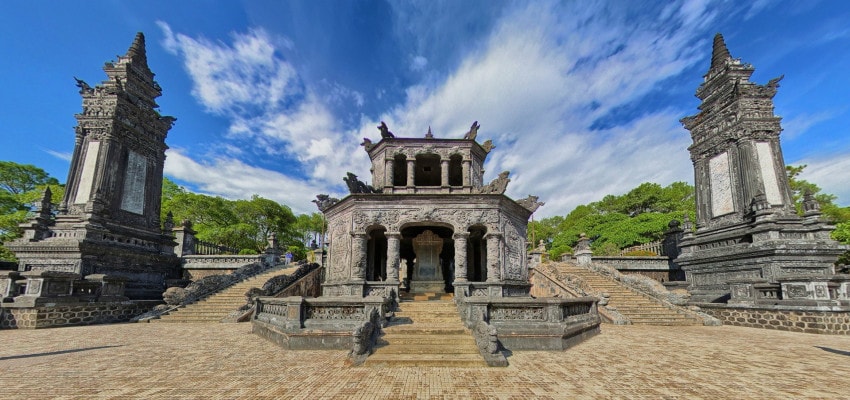
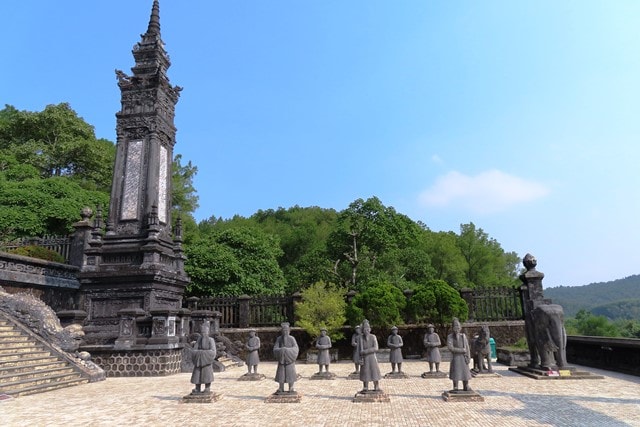

Pingback: SOME REFERENCE INFORMATION IN HUE CITY - Culture Pham Travel
Pingback: HUE TOURS AND THINGS TO DO IN HUE - Culture Pham Travel
Pingback: The Best Things To Do In Hue in 2020 - Culture Pham Travel
Pingback: TOP HUE ROYAL TOMBS YOU MUST VISIT - Culture Pham Travel
Pingback: HUE entrance fee monuments in 2020 - 2021 - Culture Pham Travel
Pingback: THINGS TO DO IN HUE VIETNAM 2022 - Culture Pham Travel
Pingback: An Dinh Palace Hue - Culture Pham Travel
Pingback: Dong Khanh Tomb- The Best Hue Royal Tombs - Culture Pham Travel